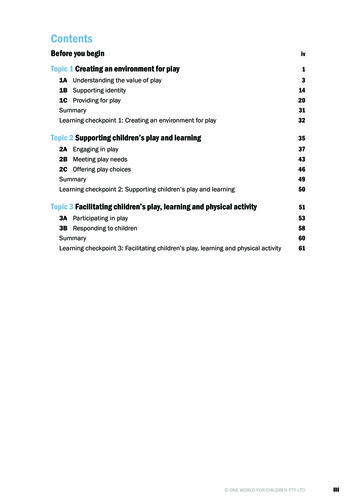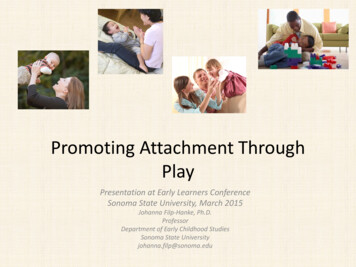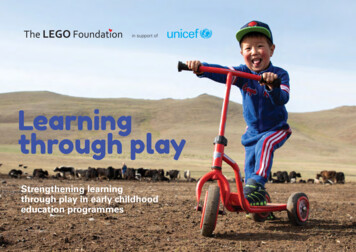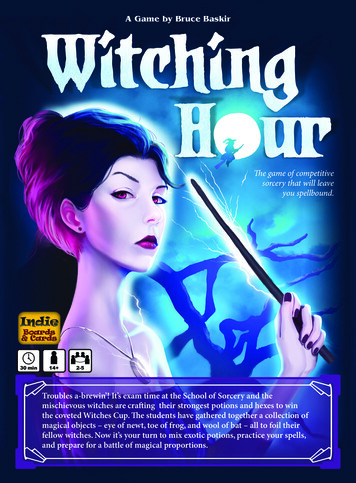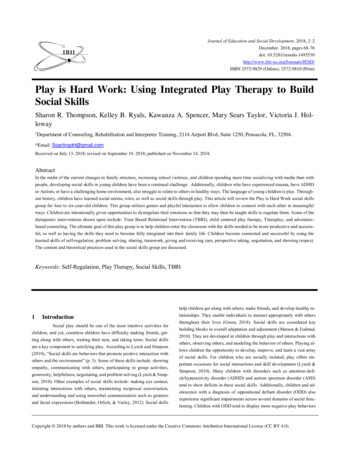
Transcription
Journal of Education and Social Development, 2018, 2–2December. 2018, pages 68-76doi: als/JESD/ISBN 2572-9829 (Online), 2572-9810 (Print)Play is Hard Work: Using Integrated Play Therapy to BuildSocial SkillsSharon R. Thompson, Kelley B. Ryals, Kawanza A. Spencer, Mary Sears Taylor, Victoria J. Holloway1Department of Counseling, Rehabilitation and Interpreter Training, 2114 Airport Blvd, Suite 1250, Pensacola, FL. 32504.*Email: Soartingdrt@gmail.comReceived on July 13, 2018; revised on September 19, 2018; published on November 24, 2018AbstractIn the midst of the current changes in family structure, increasing school violence, and children spending more time socializing with media than withpeople, developing social skills in young children have been a continual challenge. Additionally, children who have experienced trauma, have ADHDor Autism, or have a challenging home environment, also struggle to relate to others in healthy ways. The language of young children is play. Throughout history, children have learned social norms, roles, as well as social skills through play. This article will review the Play is Hard Work social skillsgroup for four to six-year-old children. This group utilizes games and playful interaction to allow children to connect with each other in meaningfulways. Children are intentionally given opportunities to dysregulate their emotions so that they may then be taught skills to regulate them. Some of thetherapeutic interventions drawn upon include: Trust Based Relational Intervention (TBRI), child centered play therapy, T heraplay, and adventurebased counseling. The ultimate goal of this play group is to help children enter the classroom with the skills needed to be more productive and successful, as well as having the skills they need to become fully integrated into their family life. Children become connected and successful by using thelearned skills of self-regulation, problem solving, sharing, teamwork, giving and receiving care, perspective taking, negotiation, and showing respect.The content and theoretical practices used in the social skills group are discussed.Keywords: Self-Regulation, Play Therapy, Social Skills, TBRIhelp children get along with others, make friends, and develop healthy re-1IntroductionSocial play should be one of the most intuitive activities forchildren, and yet, countless children have difficulty making friends, getting along with others, waiting their turn, and taking turns. Social skillsare a key component to satisfying play. According to Lynch and Simpson(2010), “Social skills are behaviors that promote positive interaction withothers and the environment” (p. 3). Some of these skills include: showingempathy, communicating with others, participating in group activities,generosity, helpfulness, negotiating, and problem solving (Lynch & Simpson, 2010). Other examples of social skills include: making eye contact,initiating interactions with others, maintaining reciprocal conversation,and understanding and using nonverbal communication such as gesturesand facial expressions (Bohlander, Orlich, & Varley, 2012). Social skillslationships. They enable individuals to interact appropriately with othersthroughout their lives (Green, 2018). Social skills are considered keybuilding blocks in overall adaptation and adjustment (Matson & Fodstad,2010). They are developed in children through play and interactions withothers, observing others, and modeling the behavior of others. Playing allows children the opportunity to develop, improve, and learn a vast arrayof social skills. For children who are socially isolated, play offers important occasions for social interactions and skill development (Lynch &Simpson, 2010). Many children with disorders such as attention-deficit/hyperactivity disorder (ADHD) and autism spectrum disorder (ASD)tend to show deficits in these social skills. Additionally, children and adolescence with a diagnosis of oppositional defiant disorder (ODD) alsoexperience significant impairments across several domains of social functioning. Children with ODD tend to display more negative play behaviorsCopyright 2018 by authors and IBII. This work is licensed under the Creative Commons Attribution International License (CC BY 4.0).
Play is Hard Workand less social competence when compared to children without ODDfriends and have successful social interactions. Attention-deficit/hyperac-(Greene et al., 2002).tivity disorder permeates every aspect of a child’s life. For the completeFurthermore, children with these diagnoses, along with thosediagnostic criteria for ADHD, refer to Table A1.who have sensory processing issues often struggle with self-regulation.Self-regulation is important, as children rely on self-regulation skills inAutism Spectrum Disorderschool and in everyday life. Self-regulation and self-control can be easilyAccording to the Centers for Disease Control and Preventionconfused. While the two are related, they are not the same thing. Self-(CDC, 2018), ASD is a “developmental disability that can cause signifi-control is primarily a social skill, which children use to keep their behav-cant social, communication, and behavioral challenges” (para. 1). Prior toiors, emotions, and impulses in check. Self-regulation is a different typethe fifth edition of the Diagnostic and Statistical Manual of Mental Disor-of skill (Morin, n.d.). Self-regulation is the ability to manage emotions andders (DSM-5), conditions such as autistic disorder, pervasive developmen-behavior in accordance with the demands of the situation. It is a set oftal disorder not otherwise specified (PDD-NOS), and Asperger syndromeskills that enables children to direct their own behavior towards a goal,were diagnosed separately. Now, these conditions are all referred to ASD.despite the unpredictability of the world (Child Mind Institute, 2018).Individuals with ASD tend to have different ways of learning, paying at-Self-regulation allows children to manage their emotions, behavior, andtention, communicating, behaving, interacting, and reacting to thingsbody movements when they are faced with a situation that is tough to han-when compared to other people (CDC, 2018). The nature of the symptomsdle and allows them to do so while remaining focused and paying atten-of ASD leads to shortfalls in social abilities. In fact, social issues are onetion. Children who are able to self-regulate know how to calm themselvesof the most common symptoms in all types of ASD (CDC, 2015; Cotugno,down when they get upset, resist giving into frustrated outbursts, and be2009).flexible when expectations change (Morin, n.d.). Despite its value and im-Children with ASD present with a range of behaviors includingportance, children with a diagnosis of ADHD or ASD, or any other disor-an inability to understand and interpret nonverbal behaviors in others, aders that affect executive functioning and sensory processing, have diffi-failure to develop age-appropriate peer relationships, a lack of interest orculty with self-regulation, along with social skills. For children diagnosedenjoyment in social interactions, and a lack of social or emotional reci-with these disorders, play is especially important.procity (Cotugno, 2009). Children with ASD tend to avoid eye contact,One of the most commonly used interventions for young chil-have trouble relating to others, have difficulty expressing needs using typ-dren with social deficits is social skills training, many of which includeical words or motions, and have unusual reactions to the way things smell,play therapy techniques (Bohlander et al., 2012). Play is one of the besttaste, feel, or sound. They often repeat actions over and over again, andways for children to learn social skills because children learn best whenecho words or phrases. They also have trouble adapting to change (CDC,they are having fun. While social skills training may be individual, or2018). Due to these issues, children with ASD often avoid social contacts,group based, there are several benefits to using a group format when ap-experience an over-arousal in social situations, and demonstrate an inabil-plying the intervention to children. In a group format, children can learnity to understand and follow social rules and expectations. These issuesfrom each other, encourage each other, solve problems together, and sharecreate significant problems in engaging in normal and typical peer socialjoys and disappointments. Group play interventions offer a dynamic ap-interactions, which often result in tacit or explicit social rejectionproach for developing and refining social skills for children (Reddy,(Cotugno, 2009). For the complete diagnostic criteria for ASD, refer to2012). Group work allows children and adolescents the opportunities toTable A2.maximize their self-control and practice their social skills within the con-The Importance of Playtext of a controlled environment (Rose & Anketell, 2009). Group play in-According to Landreth (2012), “The natural medium of com-terventions can create a “teaching social laboratory” for children. Themunication for children is play and activity” (p. 7). The toys are viewedgroup serves as a practice arena in which children can experiment with oldas a child’s words and play is considered a child’s language (Landreth &and new behaviors, identify feelings and behaviors in themselves and oth-Bratton, 1999; Landreth, 2012). Using play, therapists may help childreners, and learn how their behaviors affect others as well as the environmentlearn more adaptive behaviors, especially when emotional or social skill(Reddy, 2012).deficits are present (Pedro-Carroll & Reddy, 2005). Play allows childrento use their creativity while developing their imagination, dexterity, andAttention-Deficit/Hyperactivity Disorderphysical, emotional, and cognitive strength. It is essential to developmentAttention-deficit/hyperactivity disorder is a mental disorderbecause it contributes to the cognitive, physical, social, and emotionalcharacterized by three core symptoms: inattention, hyperactivity, and im-well-being of children (Ginsburg, 2007). For children, play is a mediumpulsivity. ADHD is one of the most common disorders among children,of expressing feelings, exploring relationships, describing experiences,affecting 3-7% of the school population (Kilgus, Maxmen, & Ward,and disclosing wishes. Developmentally, children lack the cognitive, ver-2015). Children with a diagnosis of ADHD tend to be physically overac-bal facility to express what they feel, and emotionally are unable to focustive, distracted, disorganized, impulsive, and forgetful. They tend toon the intensity of what they feel in a manner that can be adequately ex-fidget, talk excessively, take unnecessary risks, and interrupt others. Theypressed in a verbal exchange. Therefore, children express themselvesalso have difficulty paying attention, waiting their turn, and staying onmore fully and more directly through self-initiated, spontaneous play.task (Centers for Disease Control and Prevention [CDC], 2017). Due toChildren are able to use toys to say what they are unable to say and dothese behaviors, it is often difficult for children with ADHD to makethings they would feel uncomfortable doing. Feelings and attitudes thatare too threatening for a child to express directly can be safely projected69
Thompson et al. / Journal of Education and Social Development 2018 2(2) 68-76through self-chosen toys. Play is considered the concrete expression of theand connection. These three principles include: Empowering Principles,child and is the child’s way of coping with his or her world (Landreth,Connecting Principles, and Correcting Principles (Purvis et al., 2015).2012). While there are many different approaches to teach children socialTBRI uses Empowering Principles to address physical needs, Connectingskills, this article specifically looks at the efficacy of social skills groupsPrinciples for attachment needs, and Correcting Principles to disarm fear-that use therapeutic techniques that integrate play.based behaviors and teach self-regulation (Purvis, Cross, Dansereau, &Play TherapyParris, 2013). While the intervention is based on years of attachment, sen-The Association for Play Therapy (1997) defines play therapysory processing, and neuroscience research, the heartbeat of TBRI is con-as “the systematic use of a theoretical model to establish an interpersonalnection (Karyn Purvis Institute of Child Development, 2018). Each set ofprocess wherein trained play therapists use the therapeutic powers of playprinciples has two associated sets of strategies. Ecological strategies andto help clients prevent or resolve psychosocial difficulties and achieve op-physiological strategies are associated with Empowering Principles. Eco-timal growth and development” (p. 7). Through play therapy, childrenlogical strategies include recognizing and managing transitions and estab-learn to communicate with others, express feelings, modify behavior, andlishing rituals, while physiological strategies include providing physicaldevelop problem-solving skills, as well as learn a variety of ways of relat-activity and sensory experiences, as well as meeting nutritional and hydra-ing to others. For children, play provides a safe psychological distancetion needs. The basic idea of Empowering Principles is that by attendingfrom their problems, and allows expression of thoughts and feelings thatto these principles and strategies, caregivers or adults can enhance aare appropriate to their development (Association for Play Therapy,child’s capacity for self-regulation, decrease the likelihood of negative or2016). Play therapy involves the use of specific directive or non-directivedisruptive incidents, and increase the likelihood of successful correctingtechniques to teach children the cognitive and behavioral skills that theyand connecting. The sets of strategies associated with Connecting Princi-may be lacking.ples are mindfulness awareness and engagement strategies. MindfulnessTheraplayawareness involves awareness of the child, self, and environment. Engage-Theraplay is an “engaging, playful, relationship-focused treat-ment strategies involve things such as valuing eye contact, healthy touch,ment method that is interactive, physical, personal, and fun” (Booth &and playful interaction. The Connecting Principles are essential mecha-Jernberg, 2010, p. 3). It is a short-term attachment-based intervention thatnisms for building trusting relationships and help both the Empoweringuses elements of play therapy to strengthen parent-child bonds and pro-and the Correcting principles work in practice. Finally, within Correctingmote secure attachments, self-regulation, and communication skills inPrinciples, there are two types of strategies: proactive and responsive. Pro-children (Theraplay, 2018). Theraplay interactions focus on four essentialactive strategies are about balancing structure and nurture to build trust.qualities found in parent-child relationships. These four qualities include:They are designed to teach social skills to children during calm times. Re-structure, engagement, nurture, and challenge (The Theraplay Institute,sponsive strategies provide caregivers with tools for responding to chal-2017). The dimension of structure is especially important for children withlenging behavior, such as using the IDEAL Response technique. The Cor-ASD because it not only provides a sense of safety and predictability forrecting Principles are used to deliberately shape behavior (Purvis et al.,the child, but it also allows the counselor to keep the child with them phys-2015).ically and emotionally. After the safety of structure is established, engage-Integrative Therapyment is the key Theraplay dimension when working with children with aIntegrative therapy is “a combined approach to psychotherapydiagnosis of ASD. The Theraplay principle of becoming an intriguingthat brings together different elements of specific therapies” (Counsellingforce that the child notices and takes into account is crucial because chil-Directory, 2018). This approach posits that counseling techniques must bedren with ASD find it difficult to engage with others. Nurturing providestailored to each client’s individual needs. When applying this approach tocomfort and a sense of safety, as it is the most fundamental connectiontherapeutic techniques that integrate play therapy, integrative therapy isbetween human beings. Because many children with ASD have a discom-the use of several methods of play to teach children social skills. Thesefort with being touched, it is especially important to find nurturing activi-methods need to be tailored to the child’s specific needs, using empiricallyties that are truly soothing to the child. The challenge dimension ofsupported techniques that will help the child with their specific disorderTheraplay is often used in small increments with children with ASD.and social deficits.Gradually introducing new activities and new challenges helps expandchildren’s range of abilities to interact with others and helps them tolerateLiterature Reviewa variety of new activities. Instead of overtly teaching the social skills chil-Research has shown that social skills curriculum implementeddren with ASD lack, Theraplay helps children learn these skills in a varietyin a group therapy format is beneficial and effective in improving socialof more subtle ways (Booth & Jernberg, 2010).skills in children and adolescents with disruptive behavior disordersTrust-Based Relational Intervention(DBD) and/or ASD (DeRosier, Swick, Davis, McMillen, & Matthews,Trust-based relational intervention (TBRI) is an, “attachment-2010; Mathews, Erkfritz-Gay, Knight, Lancaster, & Kupzyk, 2013; Rosebased, trauma-informed intervention that is designed to meet the complex& Anketell, 2009). Mathews et al., (2013) investigated the effects of aneeds of vulnerable children” (Karyn Purvis Institute of Child Develop-social skills group that focused on verbal and nonverbal skills on the socialment, 2018, para. 1). TBRI is an intervention grounded in attachment the-functioning of children and adolescents with ASD or DBD. The groupsory. It seeks to improve outcomes for vulnerable children by helping care-were small, limited to a total of eight individuals in each group. Whengivers see the needs of children who have experienced relational traumacomparing pre- and post- test scores, results indicated an increase in alland by helping caregivers do what is necessary to meet those needs. Itfive skills being observed. For sharing ideas, complimenting others, offer-consists of three sets of principles that facilitate felt-safety, self-regulation,70
Play is Hard Working help and encouragement, recommending changes nicely, and exercis-measures of alertness, contentedness, and calmness were all higher. Theing self-control, the mean increase was 28.6%, 20.3%, 30.7%, 29.9%, andfindings indicate that chewing gum was associated with improved atten-23.7%, respectively. The results from the study conducted by Mathews ettional task performance. These results support and show the benefits ofal. (2013) suggest that when skills are directly targeted with social skillschewing gum.training, participants with ASD and/or DBD perform significantly betterResearch has also shown that social skills groups and play ther-than when they have not received training on a specific skill. In a studyapy are effective in addressing behavioral problems and social deficits inconducted by DeRosier et al., (2010), parents in the treatment group re-children with ADHD (Gol & Jarus, 2007; Robinson, Simpson, & Hott,ported improvements in children’s social skills and sense of social self-2017; Wilkes-Gillan, Bundy, Cordier, Lincoln & Chen, 2016). Wilkes-efficacy, whereas parents in the control group reported a decline. ChildrenGillan et al. (2016) completed a randomized controlled trial to test the ef-in the intervention group also exhibited significantly greater mastery officacy of play therapy techniques on developing social skills in 29 childrensocial skills. The study conducted by DeRosier et al., (2010) supports thewith ADHD. Playfulness and social skills were measured using the Testefficacy of a social skills group intervention for improving social behav-of Playfulness (ToP). The study found that all of the participants’ meaniors in children with high functioning autism spectrum disorders.ToP scores improved significantly following treatment. More specificallyResearch also recommends applying a high level of structureand relevant to this current study, the social items on the ToP scale showedor consistency and using the same or similar routine each session whena significant increase. These findings support the use of peer and parentrunning a social skills group for children with ASD (Cotugno, 2009; Rosemediated play therapy as a means to increase social skills in children with& Anketell, 2009). The use of a highly structured group resulted in posi-ADHD. Robinson et al. (2017) conducted a study on the effects of sixtive parental ratings, with 60-80% of parents rating that their child foundweeks of child-centered play therapy on the behavior performance of threeevery session “useful” or “very useful.” The majority of improvementsfirst-grade students with a diagnosis of ADHD. Even though only two par-were in areas such as social difficulties, communication difficulties, andticipants completed the entire six weeks, the results of all participants inwithdrawal (Rose & Anketell, 2009). Cotugno (2009) also found that im-the study are significant and relevant. One participant only completed twoplementing a group intervention that maintained a high degree of con-weeks of the study, however his results were promising. Out of all threesistency from session to session, resulted in significant improvements inparticipants, his behavior was most severe. Even with an impending movestress and anxiety management, joint attention, and flexibility and transi-and the birth of a younger sibling, he showed positive changes in six outtions in children diagnosed with ASD. It should also be noted, the groupof 10 subscales on the Direct Observation Form (DOF) after only oneof younger children (ages 7-8 years old) showed the greatest improvementweek of treatment. This suggests that child-centered play therapy helpedon teacher-preferred and peer-preferred behavior. This group also demon-him cope with stressors and changes in and outside of school. For the twostrated a greater shift to more positive and effective ways of managing andparticipants who completed all six weeks of treatment, results showed im-coping (Cotugno, 2009).provement on seven out of 10 subscales on the DOF. These findingsAllen and Barber (2015) investigated the effects of teachingplay-based social skill strategies on off-task behaviors in young children.demonstrate that child-centered play therapy in most effective in reducingsevere behaviors in children with ADHD (Robinson et al., 2017).These researchers found that a focused social skills program that incor-Tucker, Schieffer, Wills, Hull, and Murphy (2017) investi-porated play resulted in a decrease in off-task behaviors in children agesgated the effects of group-based Theraplay on social-emotional skills infive and six years old. The program allowed the students to learn how toat-risk preschool students. Following the intervention, they found that stu-express themselves and develop interpersonal skills by practicing socialdents in the play-based groups improved significantly in social-emotionalskills through play activities. The group format helped the boys practiceskills, behavioral regulation, problem-solving, and fine motor control.their social skills in a safe, non-threatening environment that allowed forTucker et al. (2017) noted that specific improvements occurred in domainsfree expression and understanding among group members (Allen & Bar-of managing feelings, cooperation, accepting limits, peer interactions andber 2015).friendships, and solving social problems. Siu (2014) also found a GroupIn addition to specific approaches, chewing gum is also bene-Theraplay program to be effective in enhancing social skills among chil-ficial for children with ADHD or ASD. There are many therapeutic usesdren with developmental disabilities. Compared to those in the controlof chewing gum. Chewing gum tends to provide the right kind of sensorygroup, children in the intervention group showed significant improve-feedback that some children crave. Nearly all children chew gum, and inments in social cognition, social awareness, social communication, anddoing so, a child with ASD may avert social stigmatization that may be asocial motivation. The greatest pre- to postintervention differences werecause of concern (Stillman, 2007). Additionally, chewing gum can relievefound in social motivation and social communication, which includedstress, increase attentiveness, boost concentration, and aid in accessingskills such as picking up social cues and learning to reciprocate social be-memory (Allen & Smith, 2012; Johnson, Muneem, & Miles, 2013; Still-havior. Results from Siu (2014) and Tucker et al. (2017) show that theman, 2007). Allen and Smith (2012) investigated the benefits of chewingmore positive experience children have in working with others and thegun on alertness and attention. They found that chewing gun increasedmore comfortable they are in attending to and caring for one another, thereported alertness and hedonic tone and improved performance on the cat-more successful they are in their social relationships. These studies sup-egoric search task. These results suggest that chewing gum has a positiveport the effectiveness of using Theraplay techniques in a group format aseffect on selective attention. Additionally, Johnson et al. (2013) examineda method of improving social skills in children.the effects of chewing gum on sustained attention and associated changesin subjective alertness. Following the chewing of gum, subjective2Method71
Thompson et al. / Journal of Education and Social Development 2018 2(2) 68-76ParticipantParticipants in this study were randomly selected from a ruralcommunity in Florida. Participants included six boys and six girls (n 12)with an age range of 4 to 6 years old. Of these participants, six childrenwere diagnosed as having ASD and attachment disorder, four were diagnosed as having ADHD, one participant was diagnosed as having ODD,and one participant was neurotypical but showed signs of social difficulties. Additionally, it should be noted that five of the participants have asignificant history of early childhood trauma. All participants attended atotal of 10 two-hour group sessions every other week.InstrumentThe Test of Playfulness (ToP) was utilized to rate participants’level of playfulness and social skills both before and after the social skillsintervention was held. This 29-item measure uses observational data collected by researchers involved in the group to determine the changes ineach child’s social behavior during play. The ToP uses a 4-point scale toscore the extent, intensity, and skillfulness of each area of social skillswhile observing peer-to-peer play interactions. For the purpose of this3. Engages insocial play4. Supportsplay of others5. Enters agroup alreadyengaged in anactivity6. Initiates playwith others7. Shares (toys,equipment,friends, ideas)8. Gives readilyunderstandablecues (facial,verbal, body)that say, “Thisis how youshould act towards me”9. Responds toothers’ cuesstudy, only the data gained through the ToP on the nine items that relateto the development of social skills will be utilized. These nine items include: the skill of initiating social interactions, the skill of negotiating, theskill of sharing, the skill of supporting another, the extent of time engagedin social interactions, the intensity of involvement with another in socialinteractions, the social skill when interacting with another, the skill of giv-Designing verbal and non-verbal cues, and the skill of responding to others’ ver-This study utilized a pretest-posttest design with a randombal and non-verbal cues (Wilkes-Gillan et al., 2016). The nine items thatsample of children ages four to six years old. The dependent variable wasrate social skills on the ToP can be gauged by their extent, intensity, orthe participants’ social skills based on their ToP scores while the inde-skill. The ToP does not measure the extent, intensity, and skill for all ofpendent variable was the treatment plan which involved a social skillsthese nine items, it is dependent on which item is being rated. Extent isgroup that utilized an integrative approach to play therapy. The baselinerated on a scale ranging from: N/A not applicable, 0 rarely or never, 1 was found using the participants’ ToP scores prior to the intervention,some of the time, 2 much of the time, and 3 almost always. Intensity iswhile the results were found using the posttest ToP scores. The pretest andrated by: N/A not applicable, 0 not, 1 mildly, 2 moderately, and 3 posttest data were then compared to find the significance in the change ofhighly. Skill is rated by: N/A not applicable, 0 unskilled, 1 slightlyscores.skilled, 2 moderately skilled, and 3 highly skilled. For a list of items thatProcedurerate participant social skills and whether extent, intensity, and skill areThe trials consisted of 10 bi-weekly two-hour sessions led byrated for the item, refer to Table 3. This measure was chosen due to itsa licensed mental health professional along with assistance from otherempirically supported inter-rater reliability, moderate test-retest reliabil-trained mental health professionals. Each session began with an “openingity, and inter-rater reliability coefficients (.50-.89).circle” in
with these disorders, play is especially important. One of the most commonly used interventions for young chil-dren with social deficits is social skills training, many of which include play therapy techniques (Bohlander et al., 2012). Play is one of the best ways for children to learn social skills because children learn best when

